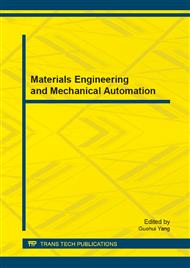[1]
Forgacs E, Cserháti T, Oros G, 2004. Removal of synthetic dyes from wastewaters: a review. Environment International, 30: 953–971.
DOI: 10.1016/j.envint.2004.02.001
Google Scholar
[2]
Robinson T, McMullan G, Marchant R, Nigam P, 2001. Remediation of dyes in textile effluent: a critical review on current treatment technologies with a proposed alternative. Bioresource Technology, 77: 247-255.
DOI: 10.1016/s0960-8524(00)00080-8
Google Scholar
[3]
Wesenberg D, Kyriakides I, Agathos SN, 2003. White-rot fungi and their enzymes for the treatment of industrial dye effluents. Biotechnology Advances, 22: 161-187.
DOI: 10.1016/j.biotechadv.2003.08.011
Google Scholar
[4]
Baldrian P, 2006. Fungal laccases-occurrence and properties. FEMS Microbiology Reviews, 30: 215-242.
DOI: 10.1111/j.1574-4976.2005.00010.x
Google Scholar
[5]
Rodríguez Couto S, Toca Herrera JL, 2006. Industrial and biotechnological applications of laccases: A review. Biotechnology Advances, 24: 500-513.
DOI: 10.1016/j.biotechadv.2006.04.003
Google Scholar
[6]
Camarero S, Ibarra D, Martínez MJ, Martínez ÁT, 2005. Lignin-derived compounds as efficient laccase mediators for decolorization of different types of recalcitrant dyes. Applied and Environmental Microbiology, 71: 1775-1784.
DOI: 10.1128/aem.71.4.1775-1784.2005
Google Scholar
[7]
Hou H, Zhou J, Wang J, Du C, Yan B, 2004. Enhancement of laccase production by Pleurotus ostreatus and its use for the decolorization of anthraquinone dye. Process Biochemistry, 39: 1415-1419.
DOI: 10.1016/s0032-9592(03)00267-x
Google Scholar
[8]
Moldes D, Sanromán MÁ, 2006. Amelioration of the ability to decolorize dyes by laccase: relationship between redox mediators and laccase isoenzymes in Trametes versicolor. World Journal of Microbiology and Biotechnology, 22: 1197-1204.
DOI: 10.1007/s11274-006-9161-1
Google Scholar
[9]
Erkurt EA, Ünyayar A, Kumbur H, 2007. Decolorization of synthetic dyes by white rot fungi, involving laccase enzyme in the process. Process Biochemistry, 42: 1429-1435.
DOI: 10.1016/j.procbio.2007.07.011
Google Scholar
[10]
Winquist E, Moilanen U, Mettälä A, Leisola M, Hatakka A, 2008. Production of lignin modifying enzymes on industrial waste material by solid-state cultivation of fungi. Biochemical Engineering Journal, 42: 128-132.
DOI: 10.1016/j.bej.2008.06.006
Google Scholar
[11]
Gianfreda L, Sannino F, Filazzola MT, Leonowicz A, 1998. Catalytic behavior and detoxifying ability of a laccase from the fungal strain Cerrena unicolor. Journal of Molecular Catalysis B: Enzymatic, 4: 13-23.
DOI: 10.1016/s1381-1177(97)00016-7
Google Scholar


